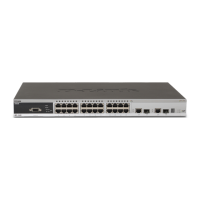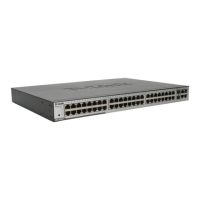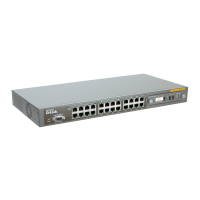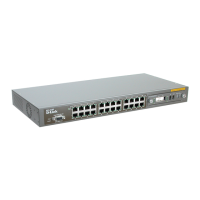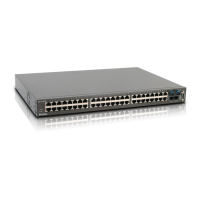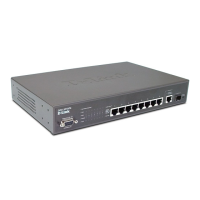Do you have a question about the D-Link DES-3550 and is the answer not in the manual?
Describes Ethernet technology, including Fast Ethernet.
Details the DES-3550 switch's hardware and capabilities.
Lists the key features and standards supported by the switch.
Describes the different types of ports available on the switch.
Details the components visible on the switch's front panel.
Explains the function of each LED indicator on the switch.
Describes the components found on the switch's rear panel.
Describes the components on the switch's side panels, focusing on ventilation.
Details the two Gigabit Ethernet combo ports for high-speed connections.
Lists the items included in the switch's packaging.
Provides guidelines for selecting an optimal installation site.
Explains how to install the switch on a desktop or shelf.
Guides the user on mounting the switch in a standard 19-inch rack.
Provides detailed steps for rack mounting the switch.
Describes the procedure for powering on the switch and observing LEDs.
Details how to connect end devices like PCs and routers to the switch.
Explains connecting the switch to hubs or other switches.
Describes connecting to network backbones or servers using combo ports.
Outlines available methods for managing the switch (console, Telnet, web).
Describes using the CLI via the serial console port for management.
Details the physical connection and terminal emulation settings for the console port.
Guides the user through the initial connection and login process.
Explains how to set up user accounts and secure access to the switch.
Covers SNMP versions, community strings, and MIB information.
Explains managing the switch using SNMP protocols and versions.
Details how to assign an IP address to the switch for network management.
Explains how to connect devices to the switch after IP configuration.
Provides an overview of the web-based management interface.
Guides the user on accessing the switch via the web manager.
Describes the structure and areas of the web-based user interface.
Details the three distinct areas of the web manager interface.
Lists and describes the main folders available in the web interface.
Provides access to basic settings like MAC address, firmware version, and system name.
Covers configuring the switch's IP address via web manager or CLI.
Details various advanced configuration options for the switch.
Explains how to configure individual port settings like speed, duplex, and flow control.
Allows assigning descriptive names to individual switch ports.
Configures port mirroring to monitor network traffic on specific ports.
Describes combining multiple ports into a single logical link for increased bandwidth.
Explains the concept and configuration of port trunk groups.
Configures Link Aggregation Control Protocol (LACP) for dynamic link aggregation.
Monitors MAC addresses learned and entered into the forwarding database.
Covers Internet Group Management Protocol (IGMP) snooping settings.
Discusses Spanning Tree Protocol (STP) versions (802.1d, 802.1w, 802.1s).
Covers Virtual LANs, IEEE 802.1p priority, and VLAN configuration.
Explains Quality of Service features, including 802.1p priority queuing.
Allows specifying IP addresses for remote management access.
Manages user accounts and their privilege levels (Admin/User).
Covers security protocols like TACACS, XTACACS, and RADIUS for authentication.
Enables secure communication through encryption and digital signatures.
Provides secure remote login and network services.
Details SNMP settings, user tables, views, groups, and hosts for network management.
Displays the percentage of bandwidth used on each port.
Shows the percentage of CPU usage on the switch.
Provides statistics on received and transmitted packets (bytes, counts).
Displays port error statistics like CRC errors, undersize, oversize, and drops.
Allows viewing the switch's dynamic MAC address forwarding table.
Records and displays events and system activities.
Manages firmware upgrades and configuration file transfers via TFTP.
Verifies network connectivity by sending ICMP Echo packets.
Explains how to save configuration changes to NV-RAM.
Provides options to reset the switch to factory defaults.
Introduces the SIM feature for managing multiple switches as a single entity.
Describes how to view and manage the network topology within a SIM group.
Explains how tooltips in the topology view provide device and connection information.
Covers general standards, protocols, data rates, topology, and network cables.
Details switch performance metrics like packet buffer and MAC learning.
Explains RJ-45 connectors and their pin assignments for network connections.
Provides a guide to maximum cable lengths for different network standards.
Defines technical terms and acronyms used in the manual.
Lists D-Link office contact information worldwide.
Details the hardware and software warranty terms and conditions.
Information and form for product registration.
| Model | DES-3550 |
|---|---|
| MAC Address Table Size | 8K |
| Flash Memory | 8 MB |
| Operating Humidity | 10% to 90% non-condensing |
| Type | Managed |
| Ports | 48 |
| Power Supply | Internal |
| Operating Temperature | 0°C to 50°C |
| Standards Compliance | IEEE 802.3, IEEE 802.3u, IEEE 802.3ab, IEEE 802.3x |
| Jumbo Frame Support | Yes |
| Dimensions | 440 x 250 x 44 mm (17.3 x 9.8 x 1.7 inches) |
| Storage Temperature | -20°C to 70°C |



